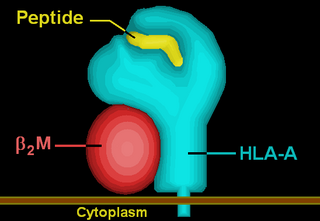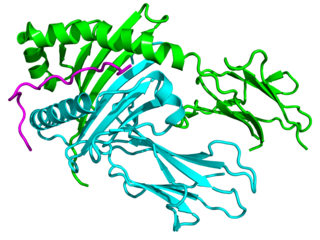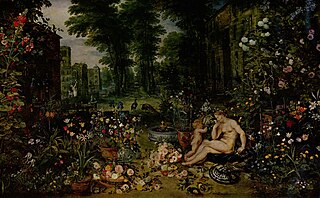Related Research Articles

Inbreeding is the production of offspring from the mating or breeding of individuals or organisms that are closely related genetically. By analogy, the term is used in human reproduction, but more commonly refers to the genetic disorders and other consequences that may arise from expression of deleterious recessive traits resulting from incestuous sexual relationships and consanguinity. Animals avoid incest only rarely.
Histocompatibility, or tissue compatibility, is the property of having the same, or sufficiently similar, alleles of a set of genes called human leukocyte antigens (HLA), or major histocompatibility complex (MHC). Each individual expresses many unique HLA proteins on the surface of their cells, which signal to the immune system whether a cell is part of the self or an invading organism. T cells recognize foreign HLA molecules and trigger an immune response to destroy the foreign cells. Histocompatibility testing is most relevant for topics related to whole organ, tissue, or stem cell transplants, where the similarity or difference between the donor's HLA alleles and the recipient's triggers the immune system to reject the transplant. The wide variety of potential HLA alleles lead to unique combinations in individuals and make matching difficult.

The major histocompatibility complex (MHC) is a large locus on vertebrate DNA containing a set of closely linked polymorphic genes that code for cell surface proteins essential for the adaptive immune system. These cell surface proteins are called MHC molecules.

The human leukocyte antigen (HLA) system or complex of genes on chromosome 6 in humans which encode cell-surface proteins responsible for regulation of the immune system. The HLA system is also known as the human version of the major histocompatibility complex (MHC) found in many animals.
Disassortative mating is a mating pattern in which individuals with dissimilar phenotypes mate with one another more frequently than would be expected under random mating. Disassortative mating reduces the mean genetic similarities within the population and produces a greater number of heterozygotes. The pattern is character specific, but does not affect allele frequencies. This nonrandom mating pattern will result in deviation from the Hardy-Weinberg principle.
Body odor or body odour (BO) is present in all animals and its intensity can be influenced by many factors. Body odor has a strong genetic basis, but can also be strongly influenced by various factors, such as sex, diet, health, and medication. The body odor of human males plays an important role in human sexual attraction, as a powerful indicator of MHC/HLA heterozygosity. Significant evidence suggests that women are attracted to men whose body odor is different from theirs, indicating that they have immune genes that are different from their own, which may produce healthier offspring.
HLA-DQ (DQ) is a cell surface receptor protein found on antigen-presenting cells. It is an αβ heterodimer of type MHC class II. The α and β chains are encoded by two loci, HLA-DQA1 and HLA-DQB1, that are adjacent to each other on chromosome band 6p21.3. Both α-chain and β-chain vary greatly. A person often produces two α-chain and two β-chain variants and thus 4 isoforms of DQ. The DQ loci are in close genetic linkage to HLA-DR, and less closely linked to HLA-DP, HLA-A, HLA-B and HLA-C.

HLA-A is a group of human leukocyte antigens (HLA) that are encoded by the HLA-A locus, which is located at human chromosome 6p21.3. HLA is a major histocompatibility complex (MHC) antigen specific to humans. HLA-A is one of three major types of human MHC class I transmembrane proteins. The others are HLA-B and HLA-C. The protein is a heterodimer, and is composed of a heavy α chain and smaller β chain. The α chain is encoded by a variant HLA-A gene, and the β chain (β2-microglobulin) is an invariant β2 microglobulin molecule. The β2 microglobulin protein is encoded by the B2M gene, which is located at chromosome 15q21.1 in humans.

Mate choice is one of the primary mechanisms under which evolution can occur. It is characterized by a "selective response by animals to particular stimuli" which can be observed as behavior. In other words, before an animal engages with a potential mate, they first evaluate various aspects of that mate which are indicative of quality—such as the resources or phenotypes they have—and evaluate whether or not those particular trait(s) are somehow beneficial to them. The evaluation will then incur a response of some sort.
Claus Wedekind is a Swiss biological researcher notable for his 1995 study that determined a major histocompatibility complex (MHC) dependent mate preference in humans.

HLA-A*02 (A*02) is a human leukocyte antigen serotype within the HLA-A serotype group. The serotype is determined by the antibody recognition of the α2 domain of the HLA-A α-chain. For A*02, the α chain is encoded by the HLA-A*02 gene and the β chain is encoded by the B2M locus. In 2010 the World Health Organization Naming Committee for Factors of the HLA System revised the nomenclature for HLAs. Before this revision, HLA-A*02 was also referred to as HLA-A2, HLA-A02, and HLA-A*2.

Major histocompatibility complex, class II, DQ beta 1, also known as HLA-DQB1, is a human gene and also denotes the genetic locus that contains this gene. The protein encoded by this gene is one of two proteins that are required to form the DQ heterodimer, a cell surface receptor essential to the function of the immune system.
Human leukocyte antigens (HLA) began as a list of antigens identified as a result of transplant rejection. The antigens were initially identified by categorizing and performing massive statistical analyses on interactions between blood types. This process is based upon the principle of serotypes. HLA are not typical antigens, like those found on surface of infectious agents. HLAs are alloantigens, they vary from individual to individual as a result of genetic differences. An organ called the thymus is responsible for ensuring that any T-cells that attack self proteins are not allowed to live. In essence, every individual's immune system is tuned to the specific set of HLA and self proteins produced by that individual; where this goes awry is when tissues are transferred to another person. Since individuals almost always have different "banks" of HLAs, the immune system of the recipient recognizes the transplanted tissue as non-self and destroys the foreign tissue, leading to transplant rejection. It was through the realization of this that HLAs were discovered.
Interpersonal compatibility or interpersonal matching is the long-term interaction between two or more individuals in terms of the ease and comfort of communication.

An odor or odour is caused by one or more volatilized chemical compounds that are generally found in low concentrations that humans and many animals can perceive via their sense of smell. An odor is also called a "smell" or a "scent", which can refer to either an unpleasant or a pleasant odor.
Odour is sensory stimulation of the olfactory membrane of the nose by a group of molecules. Certain body odours are connected to human sexual attraction. Humans can make use of body odour subconsciously to identify whether a potential mate will pass on favourable traits to their offspring. Body odour may provide significant cues about the genetic quality, health and reproductive success of a potential mate.

The major histocompatibility complex in sexual selection concerns how major histocompatibility complex (MHC) molecules allow for immune system surveillance of the population of protein molecules in a host's cells. In 1976, Yamazaki et al. demonstrated a sexual selection mate choice by male mice for females of a different MHC.
The ovulatory shift hypothesis holds that women experience evolutionarily adaptive changes in subconscious thoughts and behaviors related to mating during different parts of the ovulatory cycle. It suggests that what women want, in terms of men, changes throughout the menstrual cycle. Two meta-analyses published in 2014 reached opposing conclusions on whether the existing evidence was robust enough to support the prediction that women's mate preferences change across the cycle. A newer 2018 review does not show women changing the type of men they desire at different times in their fertility cycle.
In humans, males and females differ in their strategies to acquire mates and focus on certain qualities. There are two main categories of strategies that both sexes utilize: short-term and long-term. Human mate choice, an aspect of sexual selection in humans, depends on a variety of factors, such as ecology, demography, access to resources, rank/social standing, genes, and parasite stress.
Genetic incompatibility describes the process by which mating yields offspring that are nonviable, prone to disease, or genetically defective in some way. In nature, animals can ill afford to devote costly resources for little or no reward, ergo, mating strategies have evolved to allow females to choose or otherwise determine mates which are more likely to result in viable offspring.
References
- 1 2 Wedekind, C.; Seebeck, T.; Bettens, F.; Paepke, A. J. (1995). "MHC-dependent mate preferences in humans". Proceedings of the Royal Society of London. Series B: Biological Sciences. 260 (1359): 245–249. doi:10.1098/rspb.1995.0087. PMID 7630893. S2CID 34971350.
- ↑ Garver-Apgar, Christine E.; Gangestad, Steven W.; Thornhill, Randy; Miller, Robert D.; Olp, Jon J. (2006). "Major Histocompatibility Complex Alleles, Sexual Responsivity, and Unfaithfulness in Romantic Couples". Psychological Science. 17 (10): 830–835. doi:10.1111/j.1467-9280.2006.01789.x. PMID 17100780. S2CID 15914153.
- ↑ Ober, Carole; Weitkamp, Lowell R.; Cox, Nancy; Dytch, Harvey; Kostyu, Donna; Elias, Sherman (1997). "HLA and Mate Choice in Humans". The American Journal of Human Genetics. 61 (3): 497–504. doi: 10.1086/515511 . PMC 1715964 . PMID 9326314.
- 1 2 Reznikoff-Etievant, M.F.; Bonneau, J.C.; Alcalay, D.; Cavelier, B.; Touré, C.; Lobet, R.; Netter, A. (1991). "HLA Antigen-Sharing in Couples with Repeated Spontaneous Abortions and the Birthweight of Babies in Successful Pregnancies". American Journal of Reproductive Immunology. 25 (1): 25–27. doi:10.1111/j.1600-0897.1991.tb01059.x. PMID 2029329. S2CID 768910.
- ↑ Ober, Carole; Elias, Sherman; O'Brien, Elizabeth; Kostyu, Donna D.; Hauck, Walter W.; Bombard, Allen (1988). "HLA Sharing and Fertility in Hutterite Couples: Evidence for Prenatal Selection Against Compatible Fetuses". American Journal of Reproductive Immunology and Microbiology. 18 (4): 111–115. doi:10.1111/j.1600-0897.1988.tb00245.x. PMID 3245544.
- ↑ Frazzetto, Giovanni (2010). "The science of online dating". EMBO Reports. 11 (1): 25–27. doi:10.1038/embor.2009.264. PMC 2816634 . PMID 20033090.
- ↑ Mansky, Jackie (2018-02-14). "The Dubious Science of Genetics-Based Dating". Smithsonian Magazine. Retrieved 2022-06-28.
- ↑ Penn, Dustin J.; Potts, Wayne K. (1999). "The Evolution of Mating Preferences and Major Histocompatibility Complex Genes". The American Naturalist. 153 (2): 145–164. doi:10.1086/303166. PMID 29578757. S2CID 4398891.